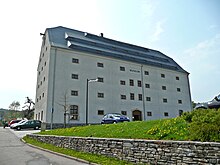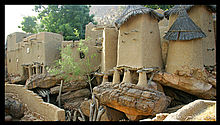Granary


A granary , and granaries , granary , granary or Granarium is a storage building mainly for grain or seed . There are many structural variants and local names, in the Low German Spieker , in the Bavarian-Austrian Troadkastn , in parts of Austria Schüttkasten and Traidkasten , because in the Bavarian dialects grain as Troat or Traid u. Ä. Is referred to. In France and even in Spanish Galicia one speaks of a grenier . The Castilian name, borrowed from Arabic , is Alhóndiga .
function
Grain stores have the task of storing the hard-working grain in a dry place, even when it rains, and protected from rising soil moisture and pests (animal damage). In some cases, larger buildings also served as tithe chests for the respective landlord or as urban storage facilities for times of need.
history
The first archaeological evidence of systematically laid out granaries can be found in the Pre-Ceramic Neolithic A (approx. 9,500-8,800 BC) z. B. from Bab edh-Dhra at the Dead Sea . The approximately 3 × 3 m large buildings had a raised floor to promote air circulation and keep pests away. Before that, there seems to have been only a small amount of granaries.
A wooden model of a granary was found in Egypt . In the north of the Iberian Peninsula there are Hórreos , the origin of which some researchers trace back to ancient times. In the Berber regions of southern Morocco there were agadirs (known as ksour in southern Tunisia ), but they also served other purposes. The Dogon warehouses in Mali, traditionally made of clay, are also impressive .
Designs
Granaries had different construction methods depending on the storage volume . While smaller storage facilities were built directly on farms , larger storage facilities were located in castles or monasteries, at ports or within cities. Different construction methods were developed with the aim of making the storage of the grain as dry and pest-free as possible.
A basic distinction is made between ground storage and silo storage . Soil storage facilities are comparable to ordinary buildings with storeys (beams), with a large area and a small height. They are accessible because to preserve the grain, it has to be poured over and over again (manually or mechanically). To dry the grain, ventilation devices such. B. Windows exist. Silo storage facilities are shaft storage facilities, i.e. buildings that are divided into individual rooms with a small footprint and a large height by vertical partition walls.
Depending on the age, size and needs, there are different technical equipment. Various conveyor systems such as winches and elevator systems , screw conveyors or conveyor belts are possible for vertical and horizontal transport . In addition, there are often scales or devices for cleaning (e.g. sieves and air sweeps ).
In dry areas there are grain pits or grain cellars. These underground tanks are built on a raised area protected from flooding .
In many cases, granaries were built away from inhabited buildings due to the high risk of fire. Since they had to be absolutely dry, every fireplace or stove , as they occur in inhabited dwellings, was a potential source of danger.
Today's possible uses
Agricultural unneeded granary can for various subsequent uses are revitalized. For example, they can be converted into apartments , restaurants or cultural and exhibition buildings.
See also
literature
- Otto Lueger (Hrsg.): Lexicon of the whole technology , Vol. 4, Stuttgart, Leipzig 1906, p. 457 [4]
- Meyers Konversations-Lexikon , Volume 11, Leipzig 1907, pp. 504–506 [5]
- Pierers Konversations-Lexikon , Volume 7, Altenburg 1859, pp. 306-310 [6]
- Johann Michael Voit : About the storage of grain in barns ... , Verlag Jenisch and Stage, 1825, online
- Encyclopædia Britannica : 11th edition, Volume 12 GRANARIES [7]
Web links
Individual evidence
- ↑ Korn and "Troad" - as different as the regions. In: pnp.de. Passauer Neue Presse , accessed on July 11, 2017 .
- ↑ Ian Kuijta, Bill Finlaysonb: Evidence for food storage and predomestication granaries 11,000 years ago in the Jordan Valley , in [Proceedings of the National Academy of Sciences], vol. 106 no. 27, 7 July 2009 online
- ↑ Otto Lueger: Lexicon of the entire technology and its auxiliary sciences , Vol. 4, Stuttgart, Leipzig 1906, p. 457. [1]
- ↑ Otto Lueger: Lexicon of the entire technology and its auxiliary sciences , Vol. 4, Stuttgart, Leipzig 1906, p. 457. [2]
- ↑ Pierer's Universal Lexikon , Volume 7. Altenburg 1859, pp. 306-310. [3]
- ↑ Voit: About the storage of grain in barns ... , 1825, p. 6, 177



